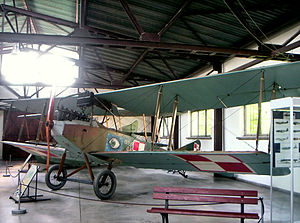| B.II | |
|---|---|
| An Albatros B.IIa in an exhibition in the Polish Aviation Museum | |
| Role | Reconnaissance aircraft |
| Manufacturer | Albatros Flugzeugwerke |
| First flight | 1914 |
| Primary users | Germany Sweden Austria-Hungary Finland |
The Albatros B.II was an unarmed German two-seat reconnaissance biplane of the First World War.
Design and development[]
Designed by Ernst Heinkel based on his 1913 Albatros B.I, the B.II was the aircraft that brought the aircraft manufacturer Albatros Flugzeugwerke to the world's attention.
The B.II had a shorter wingspan than the B.I and used a variety of engines up to 89 kW (120 hp). In 1914 it set an altitude record of 4,500 m (14,800 ft). The seating arrangement was not ideal; the pilot occupied the rear cockpit, the observer sat in front over the wings which greatly reduced his downward view while the protruding engine block almost completely obscured the view over the nose. When Albatros developed the armed C.I based on their B-series, the seat positions were swapped so that the observer/gunner had a better view and clear field of fire.
A floatplane variant of the B.II was developed, known as the W.1 or B.II-W, as was a purpose-built trainer with increased wingspan and different engines, designated the B.IIa. Further developments led to the Albatros B.III, which was produced in small numbers.
Operational history[]
First flying in 1914, large numbers of the B.II were built and, though it was relegated from front-line service in 1915 following the introduction of the armed C-type two-seaters, the B.II remained in service as a trainer until 1918 and was still operated by the Swedish Air Force in 1919 and by the Polish Air Force during the Polish-Soviet war of 1920.
Service in Sweden[]
In 1914, the German manufacturer Albatros-Flugzeugwerke GmbH of Berlin-Johannisthal, was touring several countries in northern Europe, displaying their new aircraft, the Albatros B.IIa. At the time, it was considered one of the best primary trainer aircraft. However, the landing gear and propeller were damaged when it arrived in Sweden. Due to the outbreak of World War I, no spares could be sent, and the aircraft was interned. It was repaired and used as a trainer by the Swedish Air Force. This aircraft was later copied and manufactured in Sweden by six different aircraft companies: Svenska Aeroplanfabriken (SAF), Södertelge Werkstäder (SW), Marinens Flygväsende (MFV), Nordiska Aviatikbolaget (NAB), AB Thulinverken and Flygkompaniets Verkstäder Malmen (FVM). It was the first military trainer aircraft in Sweden and received the designation Sk 1 and Ö2 in the Swedish Air Force (the two types differed slightly, mainly by choice of engine). An FVM-built Sk 1 Albatros is on public display in the Swedish Air Force Museum near Linköping. The type was being used until 1935. One aircraft was later sold to Finland.
Service in Finland[]
NAB Albatros Type 9 (and SW 20 Albatros), Type 12 and Type 17 were among the first aircraft of the Finnish Air Force. It was in use between 1918 and 1923. There were two Type 9s, and one each of the Type 12 and 17. There was also one SW 20 Albatros, which was similar to the Type 9. The Type 12 aircraft was destroyed in the ferry flight to Finland; the remains of the aircraft were found near Eckerö, Åland.
Variants[]
- B.II
- Developed from the B.I, the B.II entered production in 1914.
- B.IIa
- strengthened airframe, particularly the tail section and 120 hp (89 kW) Mercedes D.II or 120 hp (89 kW) Argus As III engines with radiators moved to the leading edge of the upper centre section.
- W.1
- Seaplane with twin floats and a 150 hp (112 kW) Benz Bz.III engine.[1]
Operators[]
- Bulgarian Air Force operated this type to 1918
- Finnish Air Force operated five aircraft postwar
- Lithuanian Air Force operated this type postwar
- Polish Air Force operated 116 B.IIs and B.IIas between 1918 and 1927. A dozen or so remained within civil aviation till 1937.
- Swedish Air Force operated 47 aircraft postwar.
- Swedish Navy operated five aircraft between 1920 and 1929.
United Kingdom of Great Britain and Ireland
- Royal Naval Air Service, Royal Flying Corps, Royal Air Force operated one aircraft from August 1914 - February 1918.[2]
Specifications (B.II with Mercedes D.II engine)[]
Data from German aircraft of the First World War[1]
General characteristics
- Crew: Two
- Length: 7.63 m (25 ft 0⅜ in)
- Wingspan: 12.8 m (42 ft 0 in)
- Height: 3.15 m (10 ft 4 in)
- Wing area: 40.12 m2 (433 ft2)
- Empty weight: 723 kg (1,591 lb)
- Gross weight: 1,071 kg (2,356 lb)
- Powerplant: 1 × Mercedes D.II, 89.5 kW (120 hp)
Performance
- Maximum speed: 120 km/h (75 mph)
- Endurance: 4 hours
- Service ceiling: 3,000 m (9,840 ft)
- Rate of climb: 1.6 m/s (320 ft/min)
See also[]
- Albatros B.I -
- Albatros B.III -
- Albatros C.III -
- Lebed XI -
- Lebed XII
- Hansa-Brandenburg B.I
- List of military aircraft of Germany
References[]
| Wikimedia Commons has media related to Albatros B.II. |
- ↑ 1.0 1.1 Gray, Peter; Owen Thetford (1970). German aircraft of the First World War (2nd ed.). London: Putnam. ISBN 0-370-00103-6.
- ↑ Jarrett, Philip (2010). "The Allies' Albatros". IPC. pp. p82-87.
| |||||
| |||||
The original article can be found at Albatros B.II and the edit history here.
